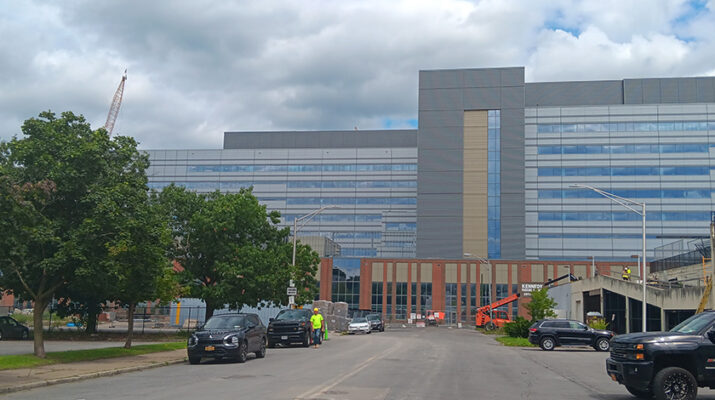All patients from St. Luke’s and St. Elizabeth hospitals will be moved on Oct. 29, the same date as the two hospitals close
By David L. Podos
What started off in 2014 as a “think tank” project for a new downtown Utica hospital, Mohawk Valley Health Services is ready to open its new hospital— nine years after its conception.
The official opening day is scheduled for Oct. 29.
The hospital is named The Wynn Hospital after Steve Wynn, who donated $50 million to the project from his family foundation. Wynn is a Utica native who made a fortune in the real estate business and the art business, as well as his involvement in the luxury hotel and casino industry.
MVHS had to deal with and work through pushback from many people, businesses and politicians who did not agree with the location of the new hospital but rather wanted the location to be on the existing site of the St. Luke’s hospital campus. Organizations such as No Hospital Downtown vehemently opposed the downtown site location as well.
All said and done one of the biggest urban renewal projects in Utica’s history is now a reality.
Caitlin McCann, VP of marketing and communications at MVHS, said the hospital is ready to transition its patients and bring top of the line world class medical services to the community and beyond.
“Our patients will be moved on Oct. 29, the same date as the current two hospitals, St. Luke’s and St. Elizabeth will close,” she said.
The moving of patients is a monumental task and of course the safety of all patients is paramount. To undertake this critical transition MVHS will be utilizing a leader in patient transition.
“To accomplish this move MVHS is working with Health Care Relocations which provides specialized relocation services to the health care industry worldwide. HCR has extensive experience having moved more than 500 hospitals,” McCann said.
HCR has been onsite at the current hospitals evaluating all items and equipment that needs to be moved to the Wynn hospital, she added.
One of the many questions from the community and public figures was what medical services will the Wynn Hospital offer that the current hospitals do not.
According to MVHS there will be many new services as well as improvements of existing medical services.
McCann listed a number of them:
• Strengthen and grow current full service cardiac offerings above becoming the first in the state to be designated a heart care center by the American College of Cardiology.
• Development of a neurosciences institute that will include a neurovascular center and comprehensive stroke center.
• A center for surgical innovation, expanding general and robotic services as well as an orthopedic institute which will expand on our current proven renowned outcomes.
• World class diagnostic center, including interventional radiology and advanced endoscopy.
• Becoming a level three trauma center with the ability to serve 90,000 emergency visits per year.
• The development of a new women’s and children’s center to meet the unique needs of these populations.
Overall the technology in the Wynn Hospital will be state-of-the-art and the physical layout of the building provides a much more efficient way for staff to deliver care.
Another important challenge for MVHS will be to figure out what to do with the two closed hospitals.
Many communities who have hospital settings as well as educational settings in close proximity of one another combine the two to create a strong economic impact within their communities while providing critical services.
Recently, Utica College — whose campus is directly across the street (Champlain Avenue) from St. Luke’s hospital — received “university” status. There might be a look into how the university might be able to use the St. Luke’s campus once the hospital is vacant. One use could be a specialized teaching hospital.
In the meantime, MVHS along with Oneida County Executive Director Anthony J. Picente with other interested partners are seeking proposal for the repurposing of St Luke’s, and along with the city of Utica, Utica IDA, MVHS and EDGE to redevelop MVHS’ St. Elizabeth’s campus.
The hospital will no doubt have a profound impact on Utica’s downtown corridor.
McCann said 3,000 to 3,500 employees will work in the medical field downtown when completed, with an average of 2,000 employees working per day.
Many once-vacant buildings near the new hospital have been rehabilitated into loft apartments, new restaurants have been popping up as well throughout the downtown area, road improvements are also underway near and around the new hospital.
Additionally, directly across from the hospital will be a new medical office building-ambulatory surgery center.

